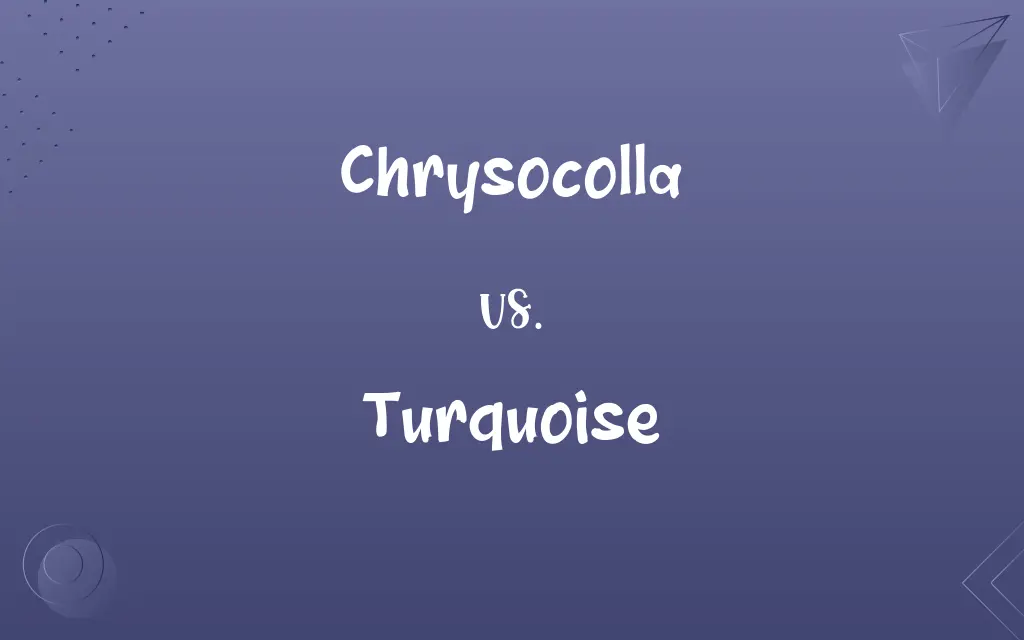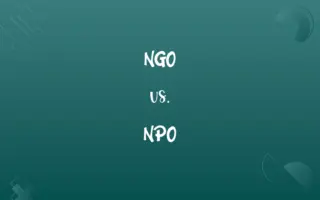Chrysocolla vs. Turquoise: Know the Difference

By Shumaila Saeed || Published on January 30, 2024
Chrysocolla is a copper silicate mineral known for its vibrant blue-green color, while Turquoise is a blue-to-green mineral, a phosphate of copper and aluminum, famed for its use in jewelry.

Key Differences
Chrysocolla is a copper silicate mineral with a distinctive blue-green color and is softer than quartz. Turquoise, on the other hand, is a hydrous phosphate of copper and aluminum, renowned for its unique blue to green hues.
Shumaila Saeed
Jan 30, 2024
The hardness of Chrysocolla varies but typically falls below that of quartz, making it somewhat delicate. Turquoise is comparatively harder but can still be prone to scratching and requires careful handling.
Shumaila Saeed
Jan 30, 2024
Chrysocolla often forms in the oxidation zones of copper-rich ore bodies, whereas turquoise forms in arid regions through the process of weathering and hydration.
Shumaila Saeed
Jan 30, 2024
In terms of appearance, Chrysocolla may present with a vitreous to dull luster and often occurs in association with quartz. Turquoise is known for its waxy to dull luster and is often found in veins or as crusts.
Shumaila Saeed
Jan 30, 2024
Chrysocolla is not just used in jewelry; it’s also a mineral of interest for collectors due to its vibrant colors and patterns. Turquoise has been highly valued in many cultures for centuries, primarily used in fine and artisan jewelry.
Shumaila Saeed
Jan 30, 2024
ADVERTISEMENT
Comparison Chart
Chemical Composition
Copper silicate
Hydrous phosphate of copper and aluminum
Shumaila Saeed
Jan 30, 2024
Formation
In copper-rich oxidation zones
Forms in arid regions through weathering
Shumaila Saeed
Jan 30, 2024
Uses and Significance
Jewelry and mineral collection
Primarily in fine and artisan jewelry
Shumaila Saeed
Jan 30, 2024
ADVERTISEMENT
Chrysocolla and Turquoise Definitions
Chrysocolla
It's known for its vibrant colors and association with quartz.
The veins of chrysocolla running through the quartz were strikingly beautiful.
Shumaila Saeed
Jan 04, 2024
Turquoise
This mineral is known for its waxy to dull luster.
The waxy luster of the turquoise made it look elegant under the light.
Shumaila Saeed
Jan 04, 2024
Chrysocolla
Chrysocolla is a copper silicate mineral with a blue-green color.
The chrysocolla stone in her necklace had a mesmerizing turquoise hue.
Shumaila Saeed
Jan 04, 2024
Turquoise
Turquoise is a blue-to-green mineral, a phosphate of copper and aluminum.
The turquoise stone had a deep, celestial blue color that was captivating.
Shumaila Saeed
Jan 04, 2024
Chrysocolla
Chrysocolla forms in the oxidation zones of copper ore bodies.
Miners discovered chrysocolla near the surface of the copper mine.
Shumaila Saeed
Jan 04, 2024
ADVERTISEMENT
Turquoise
It's renowned for its use in jewelry and ornamental art.
His collection of turquoise jewelry included pieces from around the world.
Shumaila Saeed
Jan 04, 2024
Chrysocolla
Chrysocolla is softer and less durable than many gemstones.
She chose chrysocolla for her ring, despite its delicate nature.
Shumaila Saeed
Jan 04, 2024
Turquoise
Turquoise forms in arid climates through weathering and hydration.
The desert region was known for producing high-quality turquoise.
Shumaila Saeed
Jan 04, 2024
Chrysocolla
This mineral has a vitreous to dull luster.
The chrysocolla's dull luster gave it a unique earthy appeal.
Shumaila Saeed
Jan 04, 2024
Turquoise
Turquoise has been valued in many cultures for its unique hues.
The ancient necklace of turquoise was a symbol of status and wealth.
Shumaila Saeed
Jan 04, 2024
Chrysocolla
A blue to blue-green amorphous mineral, Cu2H2(Si2O5)(OH)4 often occurring as thin seams or surface layers in the oxidation zones of copper ores.
Shumaila Saeed
Jan 04, 2024
Turquoise
A blue to blue-green mineral of aluminum and copper, mainly CuAl6(PO4)4(OH)8·4H2O, prized as a gemstone in its polished blue form.
Shumaila Saeed
Jan 04, 2024
Chrysocolla
(mineral) A vitreous silicate mineral that is a minor ore of copper, with the chemical formula (Cu2+,Al)2H2Si2O5(OH)4·nH2O.
Shumaila Saeed
Jan 04, 2024
Chrysocolla
A hydrous silicate of copper, occurring massive, of a blue or greenish blue color.
Shumaila Saeed
Jan 04, 2024
Turquoise
(countable) A sky-blue, greenish-blue, or greenish-gray semi-precious gemstone.
Shumaila Saeed
Jan 04, 2024
Turquoise
A hydrous phosphate of alumina containing a little copper; calaite. It has a blue, or bluish green, color, and usually occurs in reniform masses with a botryoidal surface.
Shumaila Saeed
Jan 04, 2024
Turquoise
Having a fine light blue color, like that of choice mineral turquoise.
Shumaila Saeed
Jan 04, 2024
Turquoise
A blue to gray green mineral consisting of copper aluminum phosphate; blue turquoise is valued as a gemstone
Shumaila Saeed
Jan 04, 2024
Repeatedly Asked Queries
What is Turquoise?
A blue-to-green mineral, a phosphate of copper and aluminum.
Shumaila Saeed
Jan 30, 2024
How is Chrysocolla formed?
It forms in the oxidation zones of copper ore bodies.
Shumaila Saeed
Jan 30, 2024
Is Turquoise durable for everyday wear?
It requires careful handling but can be used in daily wear jewelry.
Shumaila Saeed
Jan 30, 2024
How hard is Turquoise?
Harder than Chrysocolla but still prone to scratching.
Shumaila Saeed
Jan 30, 2024
What are the uses of Chrysocolla?
Used in jewelry and valued by mineral collectors.
Shumaila Saeed
Jan 30, 2024
Can Chrysocolla be used in everyday jewelry?
Due to its softness, it's better for occasional wear.
Shumaila Saeed
Jan 30, 2024
Why is Turquoise historically significant?
It's been valued in various cultures for centuries.
Shumaila Saeed
Jan 30, 2024
Is there synthetic Turquoise?
Yes, synthetic versions exist due to its popularity.
Shumaila Saeed
Jan 30, 2024
Are Chrysocolla and Turquoise often confused?
Their similar colors can cause confusion, but they are distinct minerals.
Shumaila Saeed
Jan 30, 2024
Does Chrysocolla have any historical significance?
It's been known since antiquity but not as culturally significant as turquoise.
Shumaila Saeed
Jan 30, 2024
Are there synthetic versions of Chrysocolla?
Synthetic versions are not common due to lesser demand.
Shumaila Saeed
Jan 30, 2024
How can you care for Chrysocolla jewelry?
Keep it away from harsh chemicals and store it separately.
Shumaila Saeed
Jan 30, 2024
What's the best way to care for Turquoise jewelry?
Clean with a soft cloth and avoid exposure to oils and acids.
Shumaila Saeed
Jan 30, 2024
What distinguishes Chrysocolla from Turquoise?
Their chemical composition, formation, and physical properties.
Shumaila Saeed
Jan 30, 2024
Share this page
Link for your blog / website
HTML
Link to share via messenger
About Author
Written by
Shumaila SaeedShumaila Saeed, an expert content creator with 6 years of experience, specializes in distilling complex topics into easily digestible comparisons, shining a light on the nuances that both inform and educate readers with clarity and accuracy.








































































